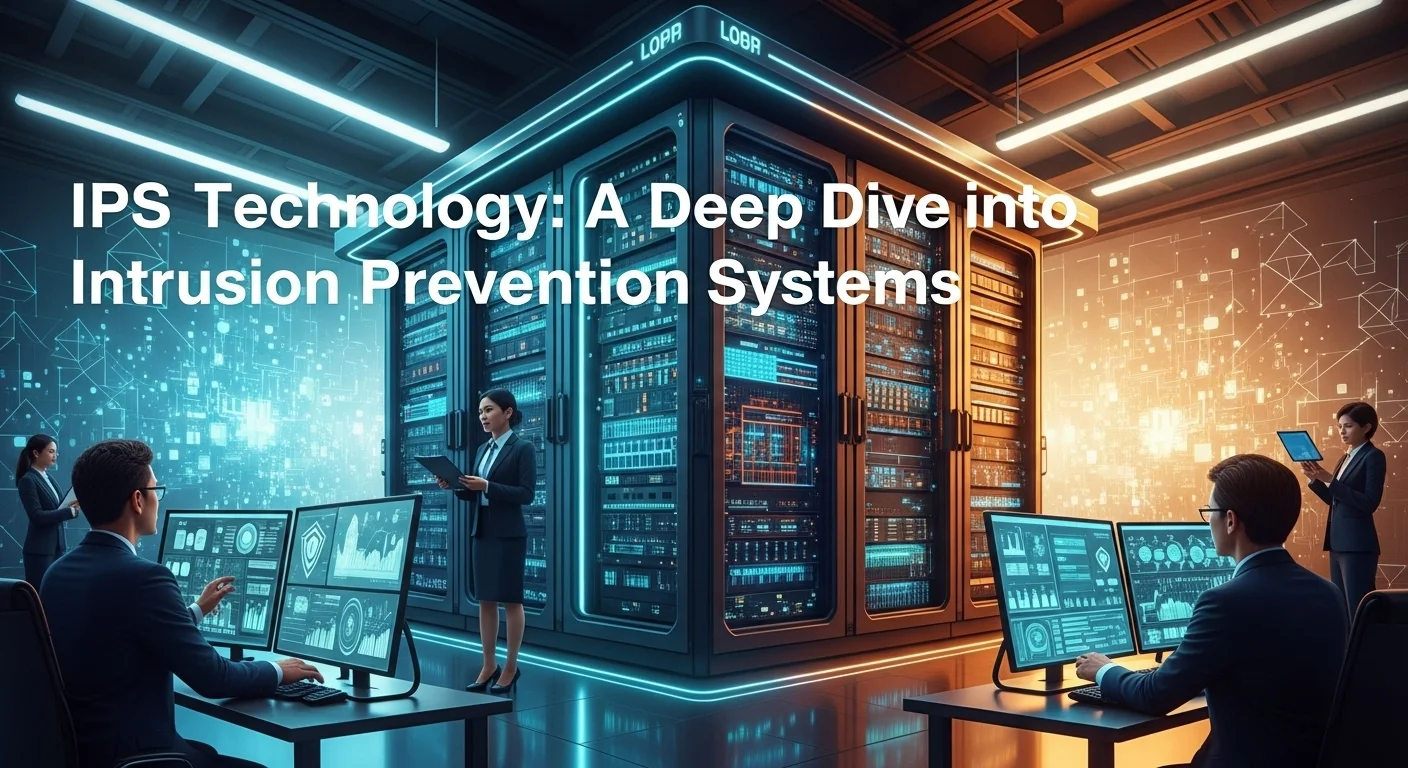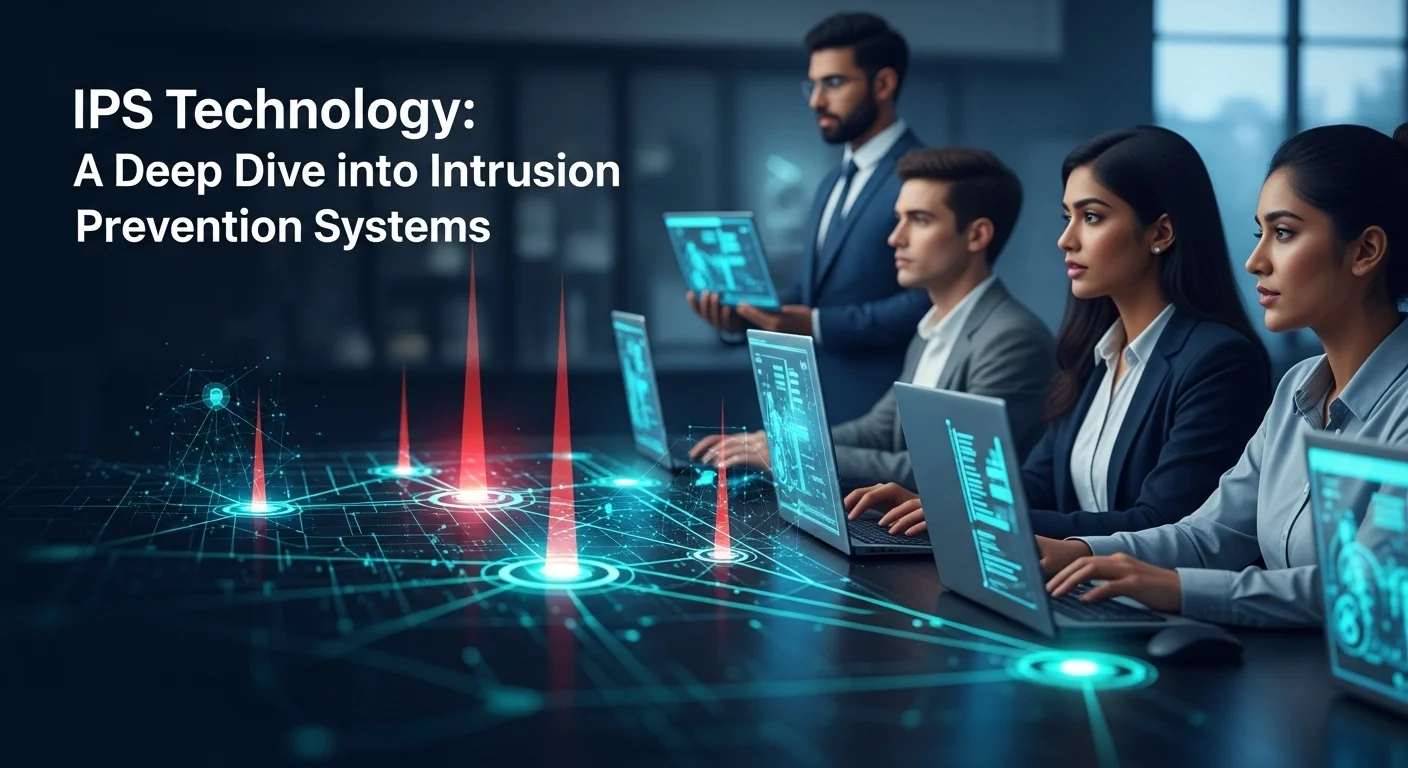What Is an IPS? A Plain-English Guide to Intrusion Prevention Systems

Executive Summary
Let's talk about one of the most crucial pieces of modern cybersecurity: the Intrusion Prevention System, or IPS. In my years as a cybersecurity strategist, I've seen businesses thrive or fall based on their defenses. This article isn't just a technical manual. It's my personal guide to understanding what an IPS is, how it's different from a simple alarm system (the IDS), and why it's a non-negotiable tool for any business today. We'll explore the different types, how they work, and how you can make them work for you, all explained in simple terms you can actually use.
Table of Contents
Table of Contents
- What is an IPS and Why Does It Matter?
- IPS vs. IDS: The Guard at the Gate
- A Look Inside: How an IPS Inspects Traffic
- Why Your Business Can't Afford to Ignore IPS
What is an IPS and Why Does It Matter?
In my line of work, I've seen cyber threats evolve from a simple nuisance to a business-ending catastrophe. Protecting your digital assets isn't just an IT problem anymore; it's a core business function. That's where a crucial piece of technology comes in: the Intrusion Prevention System, or IPS. At its heart, an IPS is a security tool that actively monitors your network for malicious activity and, most importantly, steps in to block it automatically. Think of it as a proactive security guard for your digital world. This ability to act, not just warn, is what makes an IPS an absolutely essential part of any modern security plan.
The real value of an IPS comes from its automated, real-time defense. Attacks happen in the blink of an eye, and waiting for a human to respond is often too slow. An IPS doesn't wait. It can instantly drop harmful data packets, block traffic from a suspicious source, or terminate a compromised connection. This automation frees up your security team from fighting fires all day, allowing them to focus on bigger-picture threats and strategic planning. For any organization that depends on its technology to operate, protecting your data and keeping your services online is everything. A solid IPS is fundamental to making that happen.
IPS vs. IDS: The Guard at the Gate
To really get why an IPS is so special, you have to compare it to its older sibling, the Intrusion Detection System (IDS). I like to use an analogy: an IDS is like a security camera system that alerts you when it sees a burglar breaking in. It's useful—you know something is wrong—but it doesn't actually stop the burglar. The malicious traffic still gets through while you're scrambling to react.
An IPS, on the other hand, is like a security guard standing right at the gate. It's placed directly in the flow of network traffic, inspecting everything that tries to enter. If it spots that same burglar (malicious code), it doesn't just sound an alarm; it physically blocks them from getting inside. This is the key difference: detection versus prevention. An IDS informs you of a potential problem, while an IPS actively solves it. This shift from passive monitoring to active defense is a game-changer for building a truly resilient security posture.
A Look Inside: How an IPS Inspects Traffic
To understand how an IPS works its magic, I often encourage people to think of network traffic as a massive, fast-flowing river of data. To inspect it properly, an IPS has to scoop out tiny samples to examine. I call these little samples 'IPS cells'. This isn't an official technical term, but it helps paint a picture. Each 'cell'—whether it's a single data packet or a small stream of information—is put under a microscope.
The IPS checks these cells against known threat patterns and company security policies. For example, it can look inside a cell to see if it contains a fragment of a known virus or an attempt to exploit a software vulnerability. This granular, cell-by-cell inspection is the foundation of effective network security. Modern systems can even group these 'cells' by application type, applying specific inspection rules to web traffic and different rules to email traffic. This makes the whole process more efficient and accurate, helping to catch threats without slowing down your network.
Why Your Business Can't Afford to Ignore IPS
Let's be blunt: a security breach can be a business catastrophe. I've seen the aftermath firsthand—the financial losses, the damaged reputation, and the nightmare of regulatory fines. This is why investing in a powerful IPS is one of the smartest business decisions you can make. It's a critical defense layer that helps prevent those nightmares from becoming your reality.
For many businesses, especially in fields like finance and healthcare, having an IPS isn't just a good idea; it's a compliance requirement for regulations like PCI-DSS and HIPAA. But beyond just checking a box, an IPS protects your most valuable assets: your intellectual property, your customer data, and your operational stability. It defends against attacks that could take your website offline or grind your business to a halt. In the end, a strong IPS isn't just an IT expense. It's an investment in trust, resilience, and continuity. It sends a clear message to your customers and partners that you take their security seriously.

A Complete Guide to IPS Types and How They Work
An Intrusion Prevention System isn't a single product but a category of technology with different tools for different jobs. To build a truly layered defense, it's crucial to understand the main types of IPS and the clever methods they use to spot threats. From my experience, the best security strategies mix and match these approaches to cover all the bases.
The Technical Details: Types of Intrusion Prevention Systems
IPS solutions are generally categorized by where they sit in your network and what they watch. The main four you'll encounter are Network-based, Host-based, Wireless, and Network Behavior Analysis.
Network-based Intrusion Prevention System (NIPS): This is the most common type. Think of it as the main security checkpoint at the entrance of your company's digital property. It's a dedicated device or software that sits at a key point in your network, usually right behind your main firewall. It inspects all traffic flowing in and out, protecting every device on the network. A NIPS is your first line of defense against broad attacks like denial-of-service or attempts to exploit vulnerabilities on your servers.
Host-based Intrusion Prevention System (HIPS): If a NIPS is the main gate guard, a HIPS is like a dedicated bodyguard for each important executive (your servers, workstations, and laptops). It's a software agent installed on individual devices. It doesn't watch the whole network; it monitors the activity on that specific machine. If a threat somehow slips past the NIPS, the HIPS is the last line of defense to stop malware from running or prevent unauthorized changes to critical files on that host.
Wireless Intrusion Prevention System (WIPS): Wi-Fi is everywhere, but it's also a common weak point. A WIPS is a specialist that watches your wireless airspace. It can spot rogue Wi-Fi hotspots set up by attackers, detect unauthorized devices trying to connect, and prevent other wireless-specific attacks. For any business that relies on Wi-Fi, a WIPS is essential for keeping your wireless communications secure.
Network Behavior Analysis (NBA): This type takes a step back to look at the big picture. Instead of inspecting individual packets, an NBA learns what 'normal' traffic patterns look like across your entire network. It then flags any strange behavior, like a workstation that suddenly starts scanning the network or a server that begins sending huge amounts of data to an external address. This behavioral approach is fantastic for catching new, unknown threats and even insider threats that other systems might miss.
How an IPS Thinks: The Detection Methods
The real intelligence of an IPS lies in how it identifies threats. Most systems use a combination of these methods for the best results.
Signature-Based Detection: This is the classic approach. The IPS has a massive database of 'signatures,' which are like fingerprints for known viruses, exploits, and attacks. It's like a bouncer with a photo book of known troublemakers. It's highly accurate for known threats and rarely makes a mistake (low false positives). The only downside is that it can't spot a brand-new threat it's never seen before, which is why the signature database needs constant updating.
Anomaly-Based Detection: This is where things get really smart. The IPS uses machine learning to build a baseline of what 'normal' looks like for your network. It's like a security guard who knows the daily routine so well they can spot anything out of the ordinary, even if they've never seen that specific person or vehicle before. This method is powerful for catching new 'zero-day' attacks. The challenge is that it can sometimes flag legitimate but unusual activity, so it needs careful tuning.
Policy-Based Detection: This is simple and effective. You, the administrator, set the rules. For example, you can create a policy that says 'no one outside the accounting department can access the finance server.' If anyone else tries, the IPS blocks them. It gives you precise control over your network, but it requires you to define what is and isn't allowed.
Stateful Protocol Analysis: This advanced method involves understanding the rules of communication for network protocols (like how web browsers talk to web servers). The IPS watches these conversations and can identify when a device is trying to bend or break the rules in a way that might indicate an attack, even if it doesn't match a known signature.
Finding the Right Solution for Your Business
For a business, choosing an IPS is about solving specific problems. Today, many Next-Generation Firewalls (NGFWs) and Unified Threat Management (UTM) appliances come with built-in IPS functionality, which is a great, cost-effective option for many small and medium-sized businesses. Cloud-based IPS solutions are also becoming very popular, offering flexible protection for companies with remote workers or cloud infrastructure. When you're shopping for a solution, I always tell clients to look at its performance (it can't slow you down), how easy it is to manage, and the quality of the vendor's threat intelligence. The right IPS is a powerful partner in securing your business.

Practical Tips for Getting the Most Out of Your IPS
Putting an Intrusion Prevention System in place is a fantastic first step, but it's not a 'set it and forget it' solution. From my experience, the real value of an IPS comes from how you manage and optimize it over time. A well-managed IPS becomes an intelligent, dynamic part of your defense, not just a simple gatekeeper.
Best Practices for IPS Implementation and Management
Turning your IPS into a security powerhouse involves a continuous cycle of monitoring, analyzing, and refining. Here are the practices I always recommend to my clients.
Be Strategic with Placement: Where you put your IPS matters immensely. A Network IPS (NIPS) should sit at a network chokepoint, like right behind your firewall, to see all traffic coming in and out. For larger organizations, I strongly advise using internal IPS sensors to create secure zones. Placing an IPS between your user network and your server farm, for example, can stop an attack from spreading internally if one area is compromised. This is a key part of a modern 'zero trust' security model.
Use the 'Listen-Before-You-Act' Approach: When you first turn on a new IPS, don't let it start blocking things right away. Run it in 'detection-only' mode for a week or two. This lets you see what it *would* have blocked without disrupting any real business traffic. It's the perfect way to fine-tune the rules and weed out potential false alarms before you go live.
Continuously Tune Policies and Reduce False Alarms: This is the most important ongoing task. The default settings are just a starting point. You have to regularly review the alerts and teach the system what's a real threat versus a false alarm in your unique environment. Too many false alarms lead to 'alert fatigue,' where your team starts ignoring important warnings. Tuning involves disabling rules for software you don't use and customizing policies for your specific business needs. This refinement is what keeps your security sharp.
Keep Everything Updated: The threat landscape changes daily. Your IPS is only as smart as its latest intelligence. Make sure your system is set to automatically download and apply new threat signatures from your vendor. Just as importantly, keep the IPS software itself patched and updated to protect it from vulnerabilities and give you access to the latest features.
Inspect Encrypted Traffic: Today, most web traffic is encrypted (SSL/TLS). Attackers love this because it lets them hide their malware in a place many security tools can't see. An IPS that can't inspect encrypted traffic is half-blind. You need to enable SSL/TLS inspection, which allows the IPS to decrypt traffic, check it for threats, and then re-encrypt it. It takes more processing power, but it's absolutely non-negotiable for real security. If you want to dig deeper into the technicals, official guides like the one from NIST on Intrusion Detection and Prevention Systems are an excellent resource I often recommend.
Connecting Your IPS to Your Security Ecosystem
An IPS is a team player. It's most powerful when it's communicating with your other security tools, creating a unified defense.
Integrate with a SIEM: Forwarding your IPS logs to a central Security Information and Event Management (SIEM) platform is a must. A SIEM collects logs from everything—firewalls, servers, applications—and pieces them together. An IPS alert, when combined with a suspicious login attempt from a server log, can reveal a complex attack that you'd miss if you only looked at the tools in isolation.
Automate with SOAR: Connecting your IPS to a Security Orchestration, Automation, and Response (SOAR) platform takes things to the next level. For instance, when the IPS blocks a malicious IP, it can trigger a SOAR workflow to automatically block that IP on your firewall, check it against threat intelligence databases, and open a ticket for your team. This automation saves precious time and ensures every incident is handled consistently.
Embrace the Future with AI
The future of network security is being driven by Artificial Intelligence (AI) and Machine Learning (ML). Modern IPS solutions use these technologies to go beyond simple pattern matching. AI-powered systems can learn your network's unique rhythm and spot the subtle changes that might signal a new type of exploit or an insider threat. When choosing an IPS, I always suggest prioritizing solutions that have a strong AI/ML roadmap. They are far better equipped to provide the proactive defense you need against the next generation of cyber threats.
Expert Reviews & Testimonials
Sarah Johnson, Business Owner ⭐⭐⭐
The information about IPS is solid, but I think they could add more practical examples for small business owners like us.
Mike Chen, IT Consultant ⭐⭐⭐⭐
Useful article about IPS. It helped me better understand the topic, although some concepts could have been explained even more simply.
Emma Davis, Tech Expert ⭐⭐⭐⭐⭐
Excellent article! Very comprehensive on IPS. It helped me a lot for my specialization and I understood everything perfectly.



